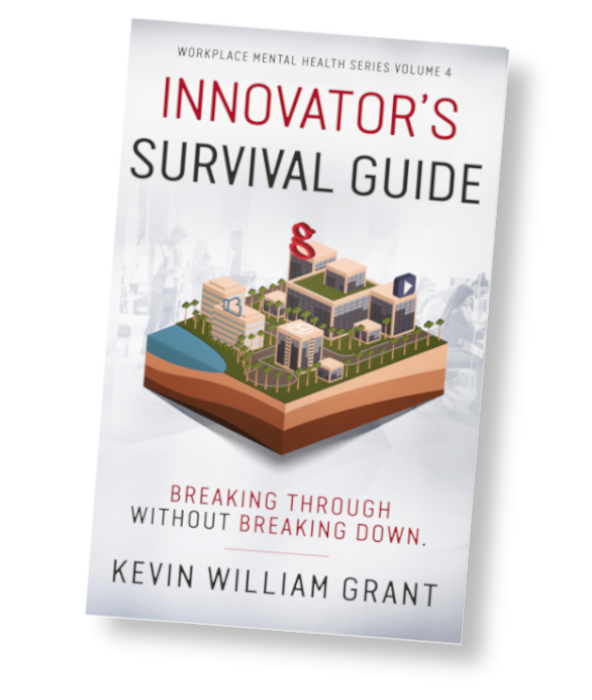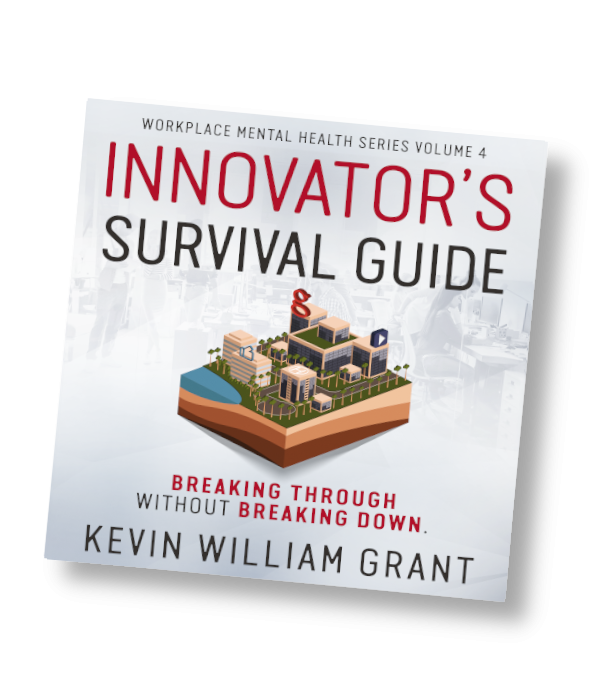
Synopsis
Innovation is essential for progress, but the journey is often fraught with challenges that can take a serious toll on mental health. From navigating workplace politics and dealing with resistance to managing the emotional ups and downs of risk-taking, the path of an innovator can be as overwhelming as it is rewarding. The Innovator’s Survival Guide is designed to help entrepreneurs, executives, creatives, and change-makers push boundaries without sacrificing their well-being.
Blending real-world corporate experience with insights from clinical psychology, coaching, and leadership development, Kevin William Grant explores the intersection of innovation, resilience, and mental health. This book provides a framework for understanding the psychological challenges innovators face and offers practical, evidence-based strategies to navigate them effectively.
What You’ll Learn:
- The Psychological Cost of Innovation – Why innovators often struggle with stress, imposter syndrome, and burnout, and how to recognize the early warning signs before they take a toll on your mental and emotional well-being.
- Managing Resistance and Workplace Politics – How to deal with corporate inertia, toxic workplace cultures, power struggles, and stakeholders who resist change. Learn how to advocate for ideas while maintaining professional and emotional balance.
- The Neuroscience of Creativity and Resilience – How innovation impacts the brain and how to harness cognitive flexibility, emotional intelligence, and strategic thinking to enhance creative problem-solving.
- Fail Fast, Adapt Faster – How to reframe failure as an opportunity, use iterative learning techniques, and develop the mindset necessary to navigate setbacks without losing momentum.
- Sustaining an Innovation Culture – How leaders can create environments that foster psychological safety, encourage experimentation, and support long-term creative success without burnout.
- Work-Life Balance for High Performers – How to set boundaries, maintain personal well-being, and prevent the exhaustion that often comes with high-stakes problem-solving and constant reinvention.
This book goes beyond traditional innovation theory by addressing the human side of change-making—the emotional, psychological, and practical realities of challenging the status quo. It provides actionable strategies to help innovators sustain their energy, stay mentally strong, and continue to drive meaningful progress without losing themselves in the process.
Whether you're building a startup, leading transformation in a corporate setting, or striving to bring new ideas to life, The Innovator’s Survival Guide equips you with the insights and tools to succeed without sacrificing your well-being.
Innovator’s Survival Guide
Breaking Through Without Breaking Down
Table of Contents
- The Power of Failure
- Business Failure
- Mental Health in the Workplace
- Support for Innovation and Entrepreneurship
- Importance of a Supportive Investment Culture
- Summary
- Synopsis
- Introduction
- Defining Innovation
- Experimentation
- The Innovation S-Curve
- Sustaining Versus Disruptive Innovation
- Incremental Versus Disruptive Innovation
- Innovation Horizons
- Innovation Process
- The Iterative Spiral Approach
- Innovation Ambition
- Fail Fast, Fail Often, Fail Cheaply
- When To Copy and Improve Rather Than Innovate
- Training Innovation May Not Be Possible
- How Innovation Succeeds
- Personality and Innovation
- Synopsis
- Persuasion
- Self-Esteem
- Confidence
- Effective Feedback
- Conflict
- Summary
- Synopsis
- Introduction
- Characteristics of Innovation Facilitating Workplaces
- Employee-Led Innovation Culture
- Common Elements of Innovation Teams
- The Innovation Lab
- Summary
- Synopsis
- Introduction
- Why Innovation is So Challenging Within an Organization
- Characteristics of Innovation Inhibiting Workplaces
- Innovation Barriers
- Workplace Power Dynamics
- Abusive Workplace Culture
- Toxic Workplaces
- Toxic Behavior
- Bullying
- Chronic Stress and Work-Life Balance
- Innovation Stress and Trauma
- Management Revenge and Being Set-up-to-Fail
- Barriers to Innovation in Banking: A Case Study
- Summary
- Synopsis
- Introduction
- Structural Factors
- Management Factors
- Innovation Theater
- Innovation Theater in Action
- Summary
- Synopsis
- Introduction
- Emotions and Innovation
- Feelings Guide Us
- Manipulation
- Guilt
- Anger and Injustice
- Managing Toxic Positivity
- Emotional Numbing
- Empathy
- Summary
- Synopsis
- Introduction
- Personality Traits that Enhance Innovation
- The Mental Health Benefits of Creativity
- Conflict
- Fear and Rejection
- Social Isolation
- The Mental Health Impacts of Innovation Stressors
- Panic Attacks
- Trauma and Post-Traumatic Stress Disorder
- Depression
- Anxiety
- Obsessive-Compulsive Disorder (OCD)
- Burnout and Stress
- The Relationship Between Mental Health and Innovation
- Summary
- Synopsis
- Introduction
- Mindfulness
- Wellness
- Trauma Recovery
- Coping with Suicidal Thoughts and Behaviors
- Building and Maintaining Your Network
- Support
- Professional Assistance
- Summary
- Synopsis
- Introduction
- Be Your Self-Advocate
- Recovery Professionals
- Finding Professional Support
- Researching Preferred Recovery Resources
- Selecting Local Professional Resources
- Schedule A Professional Consultation
- How to Get the Most out of Psychotherapy
- Summary
- Synopsis
- Introduction
- Optimism
- Life Transitions
- Working Through Loss and Grief
- The Transtheoretical Model of Behavior Change
- Life Coaching
- Navigating Employment Transitions
- Summary
- Synopsis
- The COVID-19 Pandemic
- Artificial Intelligence and Transformation
- Summary
- Synopsis
- Introduction
- Grief Coaching
- Life Transition Coaching
- Career Transition Coaching
- Managing Employment Transitions
- Finding a Healthy Workplace
- Summary
- Synopsis
- My Innovation Journey
- Closing Thoughts


